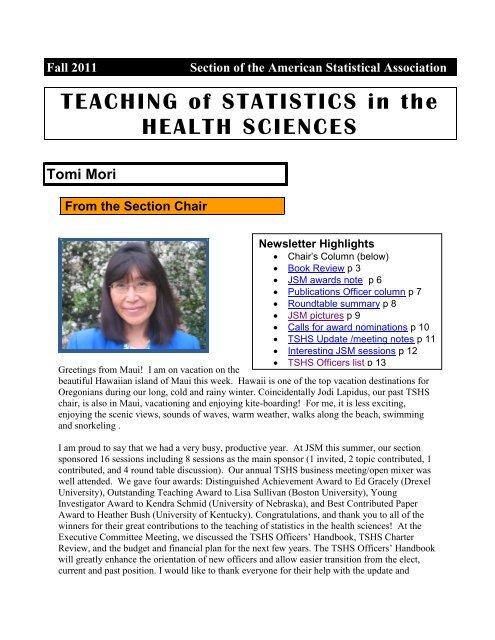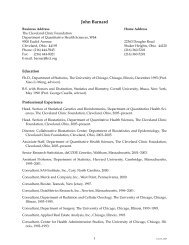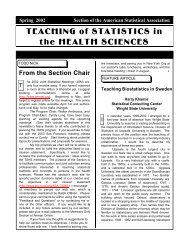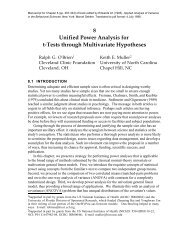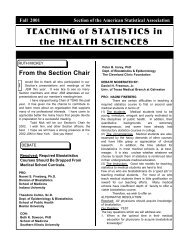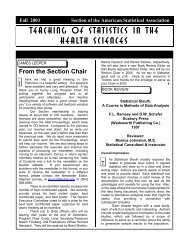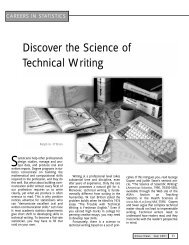Fall - Department of Biostatistics and Epidemiology
Fall - Department of Biostatistics and Epidemiology
Fall - Department of Biostatistics and Epidemiology
You also want an ePaper? Increase the reach of your titles
YUMPU automatically turns print PDFs into web optimized ePapers that Google loves.
<strong>Fall</strong> 2011Section <strong>of</strong> the American Statistical AssociationTEACHING <strong>of</strong> STATISTICS in theHEALTH SCIENCESTomi MoriFrom the Section ChairNewsletter Highlights Chair’s Column (below) Book Review p 3 JSM awards note p 6 Publications Officer column p 7 Roundtable summary p 8 JSM pictures p 9 Calls for award nominations p 10 TSHS Update /meeting notes p 11 Interesting JSM sessions p 12Greetings from Maui! I am on vacation on the TSHS Officers list p 13beautiful Hawaiian isl<strong>and</strong> <strong>of</strong> Maui this week. Hawaii is one <strong>of</strong> the top vacation destinations forOregonians during our long, cold <strong>and</strong> rainy winter. Coincidentally Jodi Lapidus, our past TSHSchair, is also in Maui, vacationing <strong>and</strong> enjoying kite-boarding! For me, it is less exciting,enjoying the scenic views, sounds <strong>of</strong> waves, warm weather, walks along the beach, swimming<strong>and</strong> snorkeling .I am proud to say that we had a very busy, productive year. At JSM this summer, our sectionsponsored 16 sessions including 8 sessions as the main sponsor (1 invited, 2 topic contributed, 1contributed, <strong>and</strong> 4 round table discussion). Our annual TSHS business meeting/open mixer waswell attended. We gave four awards: Distinguished Achievement Award to Ed Gracely (DrexelUniversity), Outst<strong>and</strong>ing Teaching Award to Lisa Sullivan (Boston University), YoungInvestigator Award to Kendra Schmid (University <strong>of</strong> Nebraska), <strong>and</strong> Best Contributed PaperAward to Heather Bush (University <strong>of</strong> Kentucky). Congratulations, <strong>and</strong> thank you to all <strong>of</strong> thewinners for their great contributions to the teaching <strong>of</strong> statistics in the health sciences! At theExecutive Committee Meeting, we discussed the TSHS Officers’ H<strong>and</strong>book, TSHS CharterReview, <strong>and</strong> the budget <strong>and</strong> financial plan for the next few years. The TSHS Officers’ H<strong>and</strong>bookwill greatly enhance the orientation <strong>of</strong> new <strong>of</strong>ficers <strong>and</strong> allow easier transition from the elect,current <strong>and</strong> past position. I would like to thank everyone for their help with the update <strong>and</strong>
2 <strong>Fall</strong> 2011 TSHSrevision <strong>of</strong> the Officers’ H<strong>and</strong>book, but in particular Constantine, who took the initiative <strong>and</strong> ledthis effort. Thank you, Constantine - our section is greatly in debt to your hard work!Please welcome our new <strong>of</strong>ficers this year: Deborah Dawson <strong>of</strong> the University <strong>of</strong> Iowa is aSecretary-Treasurer Elect, <strong>and</strong> Felicity Boyd Enders <strong>of</strong> Mayo Clinic is Program Chair Elect.Thank you both for agreeing to serve on the TSHS section. I am happy to pass the torch to CarolBigelow at the end <strong>of</strong> December, who will be our TSHS Chair in 2012. She is a long-timemember <strong>and</strong> has been actively involved in the section for many years. I feel very fortunate thatCarol will be taking over <strong>and</strong> am confident that she will do a great job. It was a privilege toserve on the TSHS, <strong>and</strong> I would like to thank everyone for their help, kind advice <strong>and</strong> guidance. Ihope to continue to be active in TSHS <strong>and</strong> to promote the TSHS mission in other pr<strong>of</strong>essionalorganizations.We are always thinking <strong>of</strong> ways to best support our mission <strong>and</strong> better serve our members. Ifyou have any suggestions or ideas, please feel free to share with us <strong>and</strong> contact me(morim@ohsu.edu). We are hoping to set up the TSHS section table at JSM next year. If youwould like to volunteer to be at the table, please let me know. Thank you all for your kindsupport, <strong>and</strong> I look forward to seeing you at JSM next summer in San Diego!Dear colleagues,Call for roundtable ideas!Do you teach statistics in the health sciences? If so, do you have a topic you think meets one <strong>of</strong> thecategories below? A burning idea you want to get people discussing A topic you want to explain or explore in a low-stress, small group setting A networking concept appropriate for a small groupI'm seeking roundtable ideas for JSM 2012 for the Section on Teaching Statistics in the Health Sciences. Ifyou're interested, please contact me at Enders.Felicity@Mayo.edu to discuss. Abstract submission beginson December 1 st .Thanks in advance for your creativity <strong>and</strong> thoughtfulness.Felicity2
3 <strong>Fall</strong> 2011 TSHSBOOKREVIEWBack to listSteven SimonP.Mean ConsultingPart-time (25%) faculty at University <strong>of</strong> Missouri-Kansas CityTitle: Impure Science: AIDS, Activism, <strong>and</strong> the Politics <strong>of</strong> KnowledgeAuthor: Steven EpsteinPublisher: University <strong>of</strong> California PressYear <strong>of</strong> Publication: 1996Number <strong>of</strong> Pages: 480ISBN‐10: 0520214455ISBN‐13: 978-0520214453Price: $28.95I found this book after a long search to verify somefolk tales that I heard. I had been telling my classesabout controversies involving placebos <strong>and</strong> howthe AIDS crisis helped us better underst<strong>and</strong> thesecontroversies. Before effective therapies for AIDSwere established, patients in placebo controlledtrials would try to subvert those trials. They (quiteunderst<strong>and</strong>ably) did not want to be in the placeboarm when they had a disease that, at that time,had no known cure. So they took their first batch <strong>of</strong>pills to a chemist, <strong>and</strong> if they found out that theyhad sugar pills, they would drop out <strong>of</strong> the study<strong>and</strong> re-enroll under a different name.Quite a story, if it is true, but I could never find adefinitive source in spite <strong>of</strong> repeated searches. Thisbook provided an answer that was far better thanwhat I had heard. With the first batch <strong>of</strong> pills, youdidn’t even need a chemist. Break open onecapsule <strong>and</strong> your tongue would know, as the drugbeing studied had a very bitter taste. The company,Burroughs Wellcome, quickly changed theformulation <strong>of</strong> the placebo to match the bittertaste <strong>of</strong> the active drug, AZT. But then patients stillhad the option <strong>of</strong> chemical analysis. Other patientswould pool their pills with other research subjectsfiguring that a 100% chance <strong>of</strong> getting 50% <strong>of</strong> therecommended dose <strong>of</strong> AZT was a better prospectthan a 50% chance <strong>of</strong> getting 0% <strong>of</strong> therecommended dose.I was grateful to finally find a definitive source formy placebo story, but this wasn’t the only valuablestory about statistics in the book. The first AIDStrials used surrogate endpoints. This wassomething that many AIDS activists were lobbyingfor. While a trial with mortality as the endpointwould provide a more valid answer to efficacy, itwould also take too long <strong>and</strong> condemn too many inthe placebo arm to unnecessary deaths. Epsteinquotes one activist “How much does one have toknow about the scientific nature <strong>of</strong> combustionwhen the house is burning down.” Epstein takesgreat pains to cite the competing arguments aboutsurrogate endpoints. In fact, the whole theme <strong>of</strong>the book is about the adjudication <strong>of</strong> scientificcontroversies, from whether the HIV virus causesAIDS to whether patients should have access toexperimental drugs outside the confines <strong>of</strong> theclinical trial.This book also <strong>of</strong>fers stories about restrictiveinclusion criteria, restrictive treatment regimens,slow patient accrual, drop outs, <strong>and</strong> compliance.While these issues were not new when the AIDScrisis came along, there is something about theresearch on AIDS that highlighted them in a way3
4 <strong>Fall</strong> 2011 TSHSthat forced the issue out <strong>of</strong> the musty confines <strong>of</strong>academic circles <strong>and</strong> into the bright light <strong>of</strong> publicscrutiny.This book is notable for the extensive commentaryfrom prominent statisticians on the front line <strong>of</strong>AIDS research, most notably David Byar <strong>and</strong> SusanEllenberg. The most inspiring part <strong>of</strong> the book forme was how Byar <strong>and</strong> Ellenberg championed amore flexible <strong>and</strong> humane approach to research inplace <strong>of</strong> the rigid insistence on scientific purity atNIH.The book is based on the postmodernphilosophical perspective, <strong>and</strong> some people mightfind this a problem. Certainly the author lapses attimes into postmodern jargon at times. I hateterms like “fetishize.” But I still found thepostmodern perspective helpful for the most part.You have to admit that the term “equipoise” is justbegging for deconstruction.We’d like to believe that our methods areobjective, but as Epstein points out, “preciselybecause every scientific experiment is by definitiona st<strong>and</strong>-in for reality, any experimental method is,in principle, open to being taken apart by thosewho claim reality is not adequately represented”(emphasis in the original). That perhaps is the mostimportant lesson <strong>of</strong> the book <strong>and</strong> is indeed a bitterpill to swallow.This is a great book for underst<strong>and</strong>ing the humanside <strong>of</strong> statistics <strong>and</strong> provides wonderfulsupplemental material for your lectures onresearch methodology.Our guest book reviewer, Steven Simon, has his own statistics newsletter, the Monthly Mean. Hedoesn't explain advanced theoretical concepts to master statisticians, but provides interesting examples<strong>and</strong> explanations that could be a useful approach to a variety <strong>of</strong> topics. Book <strong>and</strong> article reviews atvarious levels, Q & A, plus humor, <strong>and</strong> more!"Sign up for the Monthly Mean, the newsletter that dares to call itself average atwww.pmean.com/news"4
5 <strong>Fall</strong> 2011 TSHSCall for Submissions: JSM 2012 in Sunny San Diego!Jeri HarwoodIt’s that time again, to start thinking about proposals for the Joint StatisticalMeetings taking place July 28th - August 2nd, 2012 in San Diego. Onlineabstract submission for most session types opens December 1st, 2011 <strong>and</strong>closes on February 1st, 2012 at 11:59pm EST. Many <strong>of</strong> you are likely brimmingwith ideas related to Teaching Statistics in the Health Sciences <strong>and</strong> we wouldlove to see them! There are a number <strong>of</strong> different ways you can go about this, sopick what best fits your topic <strong>of</strong> interest. The choices include: 1) TopicContributed session abstracts, paper or panel form, where an entire session isorganized around a particular topic <strong>and</strong> submitted together; 2) RegularContributed abstracts which are single papers to be presented; 3) Poster “clusters”, where a set <strong>of</strong> 3-6posters submitted together; <strong>and</strong> 4) Single Posters. We are also looking for individuals who will beattending <strong>and</strong> would like to volunteer to serve as a Contributed session chair.The Topic Contributed submissions, paper <strong>and</strong> panel forms, are h<strong>and</strong>led slightly differently than theothers in that proposals should first be sent to me, your TSHS Program Committee member, atJeri.Harwood@ucdenver.edu <strong>and</strong> we will work together to get them submitted. These proposals mustbe sent to me between November 15th, 2011 <strong>and</strong> January 11th, 2012 with abstracts subsequentlysubmitted by February 1st, 2012. Here are a few basic details on Topic Contributed sessions. Papersessions consist <strong>of</strong> a collection <strong>of</strong> contributed talks <strong>and</strong> discussions (if desired) that share a commontopic. The sessions are 110 minutes in length. There must be five presentations (including discussants)<strong>of</strong> 20 minutes each, with 10 minutes at the end for floor discussion <strong>and</strong> concluding remarks by thesession chair. All speakers must submit an abstract by the deadline. There are three format options for aTopic Contributed paper session:1) Five papers2) Four papers <strong>and</strong> one discussant3) Three papers <strong>and</strong> two discussantsPanel sessions are also 110 minutes in length. The traditional panel discussion format is used, wherein aminimum <strong>of</strong> three <strong>and</strong> a maximum <strong>of</strong> five panelists provide commentary on a particular topic. Panelsrequire only one abstracted submitted by the organizer. However, all panelists are required to register forJSM.There are many other details associated with this call <strong>and</strong> rules related to how many functions anindividual can serve at one JSM, so please email me for more information on any <strong>of</strong> the session types orany general questions at Jeri.Harwood@ucdenver.edu. San Diego will certainly be cooler than Miamiwas this year, so come out <strong>and</strong> join us!5
7 <strong>Fall</strong> 2011 TSHSFROM THE PUBLICATIONS OFFICERRobert A. Oster, Ph.D., University <strong>of</strong> Alabama at BirminghamBack to listFROM THE PUBLICATIONS OFFICERContributed by Bob OsterI had a wonderful time at the 2011 Joint Statistical Meetings (JSM) inMiami Beach. There were a number <strong>of</strong> interesting speakers on each day.The general <strong>and</strong> technical sessions that I attended were informative. MiamiBeach was a fun city to visit, despite the very hot outdoor temperatures.Most <strong>of</strong> the sessions that I participated in were reasonably well attended.The only downside, which is not unique to this year’s JSM, is that therewere <strong>of</strong>ten two or more sessions that I wanted to attend at the same time.I was pleased to see many TSHS members at TSHS sessions <strong>and</strong> duringour business meeting <strong>and</strong> mixer. I thought that the TSHS sessions,posters, <strong>and</strong> roundtables (c<strong>of</strong>fee <strong>and</strong> luncheon) were well done <strong>and</strong> alsowell attended. Thank you to the individuals who spent a lot <strong>of</strong> timepreparing for these talks <strong>and</strong> discussions. I believe that the TSHS program was well received!Congratulations to those who won door prizes at our business meeting <strong>and</strong> mixer. I hope that all <strong>of</strong> youare enjoying your prizes!Regarding section publications, we will have an article published in the November issue <strong>of</strong> AmstatNews. In this article, our award winners for this year will be recognized (all but our Best ContributedPaper Award winner, who was not determined until the conclusion <strong>of</strong> the JSM, were recognized in thesummer issue <strong>of</strong> the TSHS Newsletter), <strong>and</strong> our major section awards will be announced (see below).This article may appear in Amstat News prior to the time that you are reading this column.TSHS will <strong>of</strong>fer three awards during 2012. These awards include the Outst<strong>and</strong>ing Teaching Award, theYoung Investigator Award, <strong>and</strong> the Best Contributed Paper Award. The announcements for the first twoawards appear elsewhere in this newsletter. You should have already received these announcementsvia e-mail (from the ASA Community - http://community.amstat.org), <strong>and</strong> they are also posted on theTSHS website (http://www.bio.ri.ccf.org/ASA_TSHS).Speaking <strong>of</strong> the website, the Executive Committee is always looking for relevant <strong>and</strong> up-to-datematerials to post there. This material includes documents <strong>and</strong> links to other websites/webpages. Pleasesend me or any member <strong>of</strong> the Executive Committee ideas for content that you would like to see postedon the website.I hope that you will enjoy the autumn weather, wherever you may be living. In the meantime, pleasebegin to make plans to attend JSM 2012 in sunny San Diego. Our 2012 TSHS Program Chair, JeriHarwood, is working on our program for the next JSM. She will be happy to answer any questions thatyou may have about the program.My next column, which will contain an update on TSHS publications during 2011, will appear in thespring 2012 issue <strong>of</strong> this newsletter.7
8 <strong>Fall</strong> 2011 TSHSTeaching Statistics in a Medical School Environment:Different Challenges with Different AudiencesREPORT FROM THE 2011 JSM – SESSION 495Bob OsterOur section sponsored several sessions <strong>and</strong> roundtables at the 2011 JSM in Miami Beach. I had thepleasure <strong>of</strong> chairing one <strong>of</strong> these sessions, session 495. This article is a report on session 495 from myperspective.The title <strong>of</strong> the session was “Teaching Statistics in a Medical School Environment: Different Challengeswith Different Audiences”. This was a topic contributed session, <strong>and</strong> as such, all <strong>of</strong> talks necessarilyrevolved around this topic. Our five speakers were Lori Lyn Price (Tufts CTSI), Deborah Dawson(University <strong>of</strong> Iowa), Constantine Daskalakis (Thomas Jefferson University), Mary Kwasny(Northwestern University), <strong>and</strong> John McGready (Johns Hopkins University).All <strong>of</strong> our speakers described the challenges <strong>and</strong> strategies <strong>of</strong> teaching statistics to their respectiveaudiences. Lori’s audience was residents in a teaching hospital; Deborah’s audience was dental schoolstudents, residents, <strong>and</strong> faculty; Constantine’s audience was graduate students in basic scienceprograms; Mary’s audience was nursing students; <strong>and</strong> John’s audience was public health (MPH)students. I noticed that many <strong>of</strong> the challenges <strong>of</strong> teaching statistics were similar, regardless <strong>of</strong> whichaudience was being taught. One <strong>of</strong> these challenges was that the course audiences simply did nothave much or any quantitative background (which I think is the experience <strong>of</strong> most TSHS memberswhen it comes to teaching!). I thought all <strong>of</strong> our speakers were able to develop effective strategies forteaching statistics, but that these strategies were necessarily tailored to their specific audiences. I wasimpressed that the topic <strong>of</strong> evaluating the specific teaching methods was discussed by our speakers,<strong>and</strong> also that a couple <strong>of</strong> them displayed results <strong>of</strong> their course evaluations as part <strong>of</strong> theirpresentations. I believe that all <strong>of</strong> the speakers mentioned the need for numerous <strong>and</strong> diverseexamples to be incorporated into teaching materials. Also being described in the presentations was theneed for more than straight didactic lectures; participatory methods (such as student presentations,interactions with teaching assistants, <strong>and</strong> experience with a basic statistical s<strong>of</strong>tware package) werefound to be a beneficial part <strong>of</strong> the learning process. Our speakers also noted that some in theirrespective audiences learned statistics faster than others, <strong>and</strong> mentioned how they attempted to dealwith this situation.I believe that all <strong>of</strong> the presentations were well done. In my opinion, each <strong>of</strong> them was well organized<strong>and</strong> thoughtful. During the session, many thoughtful questions were raised by the audience; thesequestions <strong>and</strong> the response <strong>of</strong> the speakers added greatly to the session. I also noted that the sessionwas well attended.I want to thank the presenters for this wonderful session, <strong>and</strong> want to give a second thank you toConstantine for organizing it. This is the type <strong>of</strong> session that reflects the essence <strong>of</strong> teaching statisticsin the health sciences in the 21 st century.8
9 <strong>Fall</strong> 2011 TSHSJSM 2011 - pictures!Front row: Sec/Treas, Constantine Daskalakis Prog Chr 2012, Jeri Forster Harwood Chair Elect, Carol Bigelow.Back row: Publications Officer, Bob Oster Newsletter Editor, Ed Gracely Past Chair, Jodi Lapidus Chair, Tomi Motomi Council <strong>of</strong> Sections Rep, CyndyLong.I knew I wasn't in Philadelphiaany more as soon as I arrivedin the airport! Cyndy Long, presenting.Lisa Kendra EdJodi Lapidus (L), Tomi Motomi (3 rdfrom right) <strong>and</strong> Carol Bigelow (2dfrom right) with award winners:Outst<strong>and</strong>ing Teaching: Lisa Sullivan;Young Investigator: Kendra Schmid;Distinguished Service: Ed Gracely9
10 <strong>Fall</strong> 2011 TSHSCALL FOR NOMINATIONS: THE 2012 ASA SECTION ON TEACHING STATISTICS IN THE HEALTHSCIENCES OUTSTANDING TEACHING AWARDDo you know a colleague who is an outst<strong>and</strong>ing teacher <strong>of</strong> statistics in the health sciences?Please nominate such outst<strong>and</strong>ing teachers for the 2012 ASA Section on Teaching Statistics in theHealth Sciences Outst<strong>and</strong>ing Teaching Award. Self-nominations are welcome.The recipient will be recognized during the 2012 JSM at the Teaching Statistics in the Health Sciencesbusiness meeting <strong>and</strong> mixer. There is an award certificate <strong>and</strong> a $500 cash award.All nominations must be made with the approval <strong>and</strong> support <strong>of</strong> the nominee.Application Materials for the Outst<strong>and</strong>ing Teaching Award include:• Cover letter from the nominator indicating that the nominee is an outst<strong>and</strong>ing teacher <strong>of</strong>statistics in the health sciences• Copy <strong>of</strong> the nominee’s curriculum vitae• Statement <strong>of</strong> the nominee’s philosophy <strong>of</strong> teaching (no more than one single-spaced page)• Three letters <strong>of</strong> recommendation submitted by colleagues who are familiar with the teachingabilities <strong>of</strong> the nomineeApplications are due by email to Tomi Mori, Award Committee Chair, Section on Teaching Statistics inthe Health Sciences, (morim@ohsu.edu) by February 1, 2012. The recipient will be notified in March2012.CALL FOR NOMINATIONS: THE 2012 ASA SECTION ON TEACHING STATISTICS IN THE HEALTHSCIENCES YOUNG INVESTIGATOR AWARD COMPETITIONAre you, or do you know, a colleague who is a “young investigator”?Please encourage “young investigators” (defined as a current graduate student or having received aterminal degree no more than 5 years ago, being in a position with rank below associate pr<strong>of</strong>essor, <strong>and</strong>not holding tenure or its equivalent) to submit abstracts to the 2012 JSM in the Section on TeachingStatistics in the Health Sciences.Abstracts submitted should be related to the use <strong>of</strong> effective methods in statistics education in thehealth sciences. Topics such as teaching in courses, consulting settings, or mentoring sessions areappropriate.For the award competition, an applicant should submit to the TSHS Section a full paper based on theabstract submitted for the 2012 JSM. Review criteria include the organization <strong>and</strong> clarity <strong>of</strong> the paper,the use <strong>of</strong> innovative or creative methods to effectively teach statistical concepts <strong>and</strong> methods, <strong>and</strong>the potential utility by others for teaching statistics in the health sciences.10
11 <strong>Fall</strong> 2011 TSHSThe applicant must be the first author <strong>of</strong> the abstract <strong>and</strong> the paper.The recipient will be recognized during the 2012 JSM at the Teaching Statistics in the Health Sciencesbusiness meeting <strong>and</strong> mixer. There is an award certificate <strong>and</strong> a $500 cash award.Application Materials for the Young Investigator Award include:• Cover letter certifying that applicant meets eligibility criteria (include title <strong>and</strong> author(s) <strong>of</strong>abstract submitted to the 2012 JSM)• Copy <strong>of</strong> abstract (include title, but not author(s))• Philosophy <strong>of</strong> teaching (no more than 1 single-spaced page; do not include applicant’s name)• Copy <strong>of</strong> paper (4-8 single-spaced pages; include title, but not author(s))Applications are due by email to Tomi Mori, Award Committee Chair, Section on Teaching Statistics inthe Health Sciences, (morim@ohsu.edu) by February 1, 2012. The recipient will be notified in March2012.From the TSHS Secretary/Treasurer: TSHS UpdatesConstantine Daskalakis, ScD, c_daskalakis@kimmelcancercenter.orgThe TSHS Executive Committee met in Miami Beach during the JSM <strong>and</strong> reviewed the section’scurrent membership information <strong>and</strong> finances. The minutes <strong>of</strong> the meeting can be found athttp://www.bio.ri.ccf.org/ASA_TSHS/html/minutes.htm. Over the past few years, membership has beenholding relatively steady, <strong>and</strong> as <strong>of</strong> the end <strong>of</strong> July 2011, the section had 676 members. Of those, 597(88%) are from the United States, 28 (4%) from Canada, <strong>and</strong> the remaining from other countries. Onehundred <strong>and</strong> eleven members (16%) are students or post-docs. The Executive Committee discussedvarious ways to more fully engage members in volunteer activities for the section. Any ideas,suggestions, or comments would be most welcome, so do not hesitate to email them to me or to anyother section <strong>of</strong>ficer. The Executive Committee also reviewed the section’s revenues <strong>and</strong> expenses <strong>and</strong>agreed on a strategic plan to keep the section’s finances healthy over the coming years. This will allowus to support the section’s awards, as well as engage in additional activities (such as the CavellBrownie Scholars Diversity Workshop <strong>and</strong> Mentoring Program, which TSHS co-sponsored at the 2011JSM). If you are considering attending the 2012 JSM in San Diego, CA, TSHS will be sponsoring or cosponsoringa number <strong>of</strong> sessions <strong>and</strong> roundtables, <strong>and</strong> possibly a short course. Look for more detailsabout these activities in our spring 2012 newsletter.11
12 <strong>Fall</strong> 2011 TSHSFrom the Editor: Some JSM notesI enjoyed JSM, <strong>and</strong> wanted to share some <strong>of</strong> what I learned <strong>and</strong> the sessions I liked.One very interesting session discussed the statistics core curriculum being promoted for high schools. 42states are committed to it now, <strong>and</strong> there is the possibility <strong>of</strong> national st<strong>and</strong>ards. It’s coming, <strong>and</strong> wemay need to rethink undergraduate statistics courses: How would you teach differently if you knew thatevery student in your class would have had statistics as a required course in high school?From another session, I loved this example (<strong>and</strong> plan to use it, or a variant, in my class, when talkingabout public numeracy): The headline said, “Eating just one sausage a day increases probability <strong>of</strong>cancer by 20%”. The presenter described having used this as a lead-in to a discussion by asking studentswhat the implications for clinicians or patients might be. One reported response was, “If I eat 5 a dayI’ll increase the risk to 100% <strong>and</strong> I’ll die!” Other responses were that eating broccoli may cancel theeffect. And, <strong>of</strong> course, why not go the other way? No sausages = no cancer!Also in that session was data showing the wide variation in the ways people interpret terms like"probable", "very likely", "likely" <strong>and</strong> so on. It's easy to think that we basically agree about such terms,but we don't!My unexpected-special session was the one put on by Significance magazine, which ASA members nowget for free. I didn't have much else to attend that time, <strong>and</strong> thought maybe there would be some mildlyinterestingdiscussions on the magazine <strong>and</strong> its role. No! They brought in speakers on 3 different <strong>and</strong>interesting topics that have been covered in the magazine. Again, I got some cool examples to use inclass, such as data from many years ago on the average age at death -- being a student was found to bethe most dangerous pr<strong>of</strong>ession <strong>of</strong> all -- students died at an average age <strong>of</strong> 22 (for the obvious reason thatthose who complete their studies <strong>and</strong> live to a ripe old age are no longer students)! A more subtleexample is to go to a cemetery <strong>and</strong> calculate the average age at death there -- it's much shorter than theactual average (because people who are still alive don't show up).Another presenter discussed exam questions <strong>of</strong> the "answer 2 out <strong>of</strong> 5" types, arguing that they havebecome unpopular in recent years, perhaps in part because they are unfair. Some people pick harderquestions <strong>and</strong> do badly on them (as do most who picked them). Students who are better test takers pickthe easier items.Ed Gracely12
13 <strong>Fall</strong> 2011 TSHSSection Officers <strong>and</strong> Officers-Elect for TSHS (as <strong>of</strong> Oct 31, 2011)Past Chair Jodi Lapidus (503) 494-1167 lapidusj@ohsu.eduChair 2011 Motomi Mori (503) 402-2871 morim@ohsu.eduChair Elect 2011 Carol Bigelow (413) 545-1319 cbigelow@schoolph.umass.eduChair Elect 2012 Steven Grambow (919) 286-0411 x 4068 steven.grambow@duke.eduProgram Chair 2011 Nichole Carlson (303) 724-4354 nichole.carlson@ucdenver.eduProgram Chair 2012 Jeri Forster Harwood (303) 724-4355 ForsterHarwood.Jeri@tchden.orgProgram Chair 2013 Felicity Enders (507) 538-4970 Enders.Felicity@Mayo.eduSecretary-Treasurer 2011 Constantine Daskalakis (215) 955-5695 c_daskalakis@KimmelCancerCenter.orgSecretary-Treasurer 2012 Deborah V. Dawson (319) 335-7189 deborah-dawson@uiowa.eduPublications Officer Bob Oster (205) 934-3376 Oster@uab.eduCouncil <strong>of</strong> Sections Rep. Cyndy Long (563) 884-5157 LONG_C@palmer.eduNewsletter Editor Ed Gracely (215) 991-8466 egracely@drexelmed.eduBook Review Editor Robert Greevy, Jr. (615) 343-5793 robert.greevy@v<strong>and</strong>erbilt.eduASA Staff Liaison Rick Peterson (703) 684-1221 x1864 rick@amstat.orgBack to listAmerican Statistical AssociationTSHS NewsletterEd J. Gracely, Ph.D. EditorFamily, Community, <strong>and</strong> Preventive MedicineDrexel College <strong>of</strong> Medicine2900 Queen LanePhiladelphia, PA 19129215-991-8466 (phone)215-843-6028 (fax)egracely@drexelmed.eduAmerican Statistical Associationhttp://www.amstat.org/Section on Teaching Statistics in the Health SciencesSection web page: http://www.bio.ri.ccf.org/ASA_TSHS/html/index.htmlLinks to all newsletters: http://www.bio.ri.ccf.org/ASA_TSHS/html/newsletter.htm13


